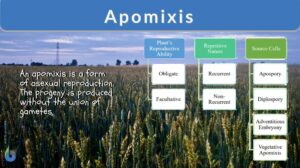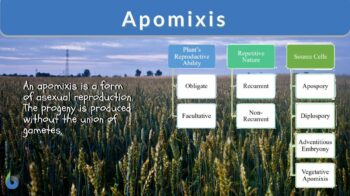
Apomixis
n., plural: apomixes
[ˌæpəˈmɪksɪs]
Definition: reproduction that does not involve fertilization an meiosis
Table of Contents
Apomixis Definition
Just like any other organism, the process of reproduction is pivotal to the life cycle of plants. There are a number of ways by which this vital process of reproduction takes place in plants. All of them fall under the umbrella of two main categories: sexual and asexual reproduction.
In sexual reproduction, two gametes of different sexes fuse and lead to a process of fertilization producing a progeny or progenies with newly constituted genetic make-up. Contrastingly, in asexual reproduction, there’s no gamete fusion or fertilization step and the progeny produced is genetically identical to the parental generation.
Got a question or an opinion on apomixis you want to talk about? Let’s discuss! Come and join us in our Forum: Asexual and sexual reproduction differences
Apomixis is an asexual reproduction that occurs without fertilization but producing embryo(s) and seed(s). One example of apomixis is apomictic parthenogenesis wherein the egg cell develops directly into an embryo without prior fertilization. The offspring from apomictic parthenogenesis would therefore be full clones of the mother. Etymology: Ancient Greek “ᾰ̓πό” (apó), meaning “away (from)” and “μίξις” (“míxis”), meaning “mixing”. Synonym: apomictic parthenogenesis. Compare: automixis, amphimixis. See also: parthenogenesis.
Among asexual reproduction, there are many types including budding, fission, vegetative reproduction, apomixis, etc. Interestingly, among asexual reproduction, only one type displays some cases of seed formation like sexual reproduction. This interesting form of asexual mode of reproduction is Apomixis!!
Parthenogenesis: An analogous mechanism to apomixis in animals…
What is apomixis in plants? In order to understand that, we need to understand that reproduction is a vital process in the lives of all living organisms, whether it be plants, animals, humans, viruses, or bacteria.
Just like Kingdom Animalia witnesses parthenogenesis — an asexual mode of reproduction where embryo development happens without fertilization by sperms — apomixis is a similar mechanism in Kingdom Plantae.
Etymologically, parthenogenesis comes from “parthenos”- meaning “virgin” and “genesis”, meaning “creation”. Occurrences of parthenogenesis in animals are very common in invertebrates like wasps, bees, nematodes, scorpions, etc.
Also, some vertebrates reproduce parthenogenetically, like some fish, reptiles (komodo dragons), and amphibians (salamanders).
Organisms with parthenogenetic reproduction can be obligate (exclusively reproduce by asexual means) or facultative (alternates between both sexual and asexual means).
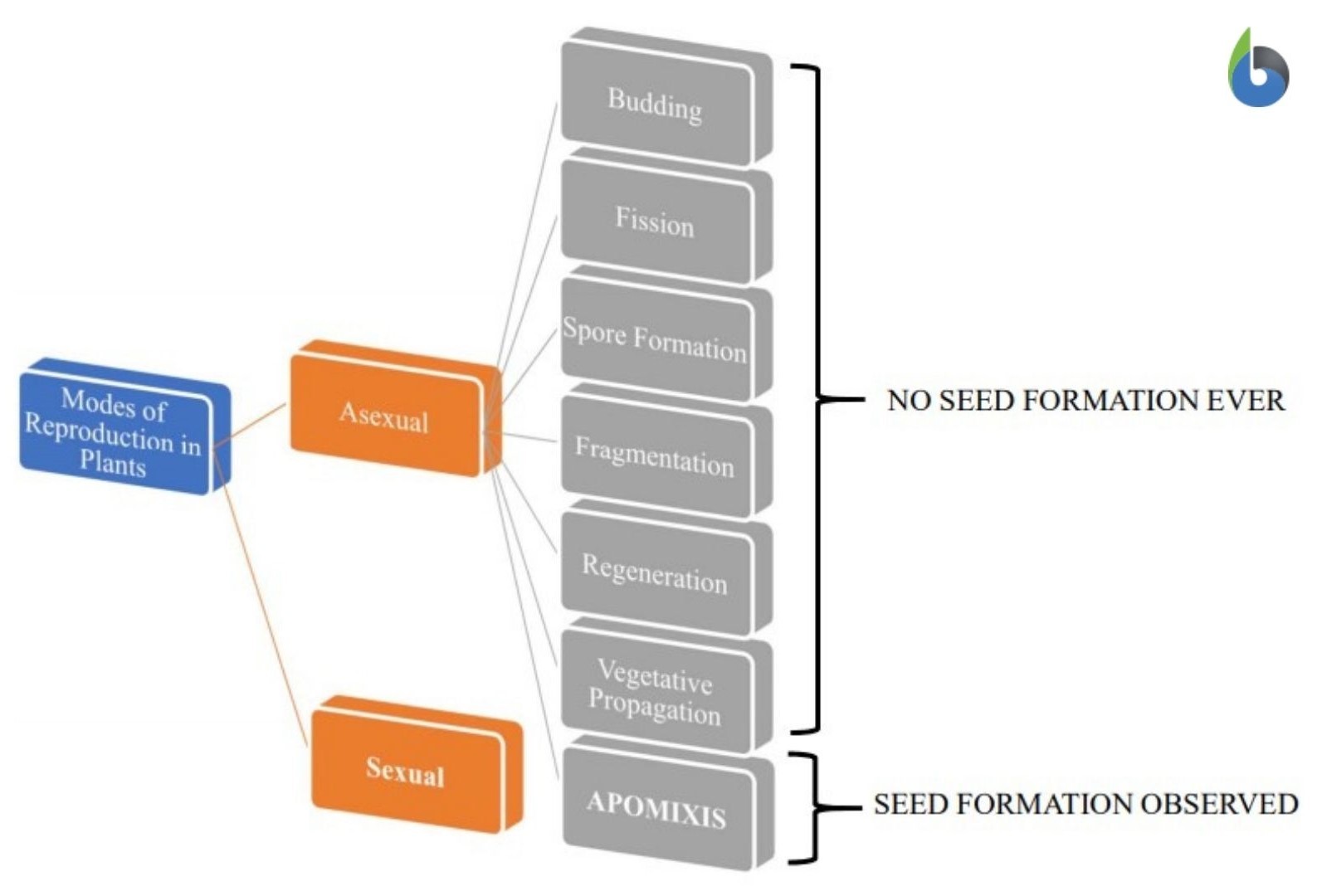
Apomixis in biology
In biology, the definition of apomixis goes by this:
“a mode of asexual reproduction in plants occurring without fertilization of sexual gametes but with the formation of embryo and seeds”.
This is a unique process by which seed formation is accomplished in the plant kingdom because in general, only gamete fusion leads to zygote formation, thereby leading to embryo formation and finally seed/s formation. But in apomixis, seed production occurs by reproduction without fertilization.
Etymologically, in Greek, apomixis comes from “apo”, meaning “away from” and “mixis”, meaning “mixing”. Many renowned scientists have worked and tried to decipher the meaning of apomixis and its various processes. Some major ones are:
- Winkler (1940): Apomixis is defined as the substitution of sexual reproduction with no type of fusions; neither nuclear nor cellular.
- Fagerlind (1940): Apomixis is defined as a type of reproduction without fertilization and lack of alternating nuclear phases.
- Richards (1997): Currently the most used and widely acceptable meaning of apomixis resonates with agamospermy. In agamospermy, embryo sac development occurs from the megaspore mother cell (MMC).
Many complexities underlie this process of apomixis. Let’s delve deeper and try to understand how apomictic processes happen, the various types of apomixes (plural form of apomixis) in nature, what exactly apomixis is – explanation with examples, and how this process evolved in the plant kingdom. Though there are many contentious issues hovering over this process, as Science advances, we are able to develop a clearer understanding.
Apomixis discovery
The phenomenon of apomixis was discovered by Winkler in 1908 when he observed a solitary female plant of Alchornea ilicifolia continuously forming seeds in Kew Gardens in England. This plant was from Australia and had no male counterpart in England. This struck Winkler of the idea that a female plant can produce seeds with no contribution from a male plant, which is unusual for a sexually reproducing plant. Hence, he termed this phenomenon as apomixis wherein no male contribution happens, and yet the seed is formed.
Apomixis importance
We need to understand what apomixis is and what its importance is. It bestows a number of advantages upon plants that make them more efficient and resilient. For example:
- Apomixis ensures that a plant reproduces even when the pollinators are absent or have gone extinct.
- Apomixis saves a lot of maternal energy that otherwise would have been wasted producing a non-viable/unfit progeny; hence the cost of meiosis is saved and less energy is expended.
- Apomixis also saves male energy in some plants by preventing the cost of producing pollen.
Importance in Horticulture Industry
- Source of genetically uniform stocks
- Source of virus-free rootstocks
- Source of some really vigorous seedlings in comparison to vegetative propagules
- Have huge significance in plant breeding programs.
Evolution of Apomixis
The number of plant taxa in which apomixis has been described till now is huge; there are about >400 flowering plant taxa. This encompasses more than 40 families of the kingdom Plantae. Although seed formation is a typical feature of both gymnosperms and angiosperms, this type of seed formation is absent in gymnosperms.
A decent number of apomictic examples exist for both types of angiosperms: monocots and dicots. Within the angiosperm families, the presence of this phenomenon is “non-uniform”. Poaceae, Asteraceae, and Rosaceae record the highest number of apomictic events; nearly 75% of all the angiosperms.
Apomictic seeds of Poa spp., Zea mays, Brachiaria spp., and other members of the grass family (Poaceae) are widely known. The largest family of angiosperms, i.e. Orchidaceae, record a meager presence of apomixis in comparison to its genera and species variety. All this hints at a prime developmental and genetic make-up that evolved particularly in some lineages of plants. Either those characteristics were predisposed to certain lineages or they evolved specifically in the course of time.
Apomixis has been associated with different phenomena like self-incompatibility, dioecy, polyploidy, and heterostyly. And it’s hypothesized that these processes have a major role in the evolution of apomixis in plants.
For example, those plant lineages that were self-incompatible have evolved in the direction of apomixis to overcome the lacunae of incompatibility. This hints that evolution might have guided self-incompatible lineages to form seeds all by themselves, thus needing no male counterpart from within the plant or from other plants.
Apomictic and self-reproductive strategies are the two main evolutionary plans of action besides sexual reproduction in flowering plants.
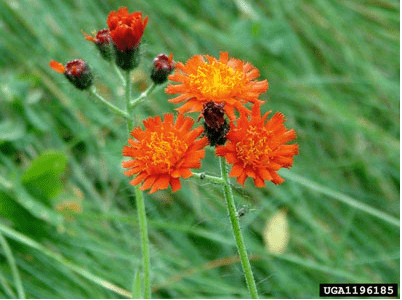
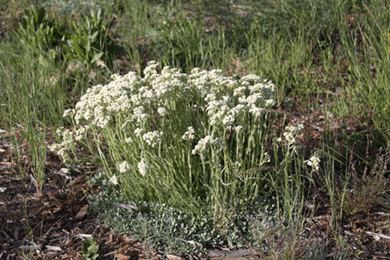
Apogamy and Apospory in Non-flowering Plants
In order to understand these two terms that are often confused with each other, we must understand the two basic processes called meiosis and fertilization. Meiosis is a reductional division that happens in sporophytic cells in order to form gametes. Fertilization is a process of fusion of two gametes in order to form a zygote.
- In apospory, sporophyte → gametophyte (without meiosis)
- In apogamy, gametophyte → sporophyte (without fertilization)
Read this if you would like to know more about meiosis and alternation of generations in plants: Meiosis and Alternation of Generations – Biology Online Tutorial.
Want an expert’s opinion about this topic? You’re more than welcome to join us here: Asexual and sexual reproduction differences.
Below is a table that further summarizes the differences between apospory and apogamy.
| Table 1: Comparison between apospory and apogamy | |
|---|---|
| Apospory | Apogamy |
| Term coined by Druery | Term coined by Heinrich Anton de Bary |
| Sporophytic cells involved are- Nucellar Cells | Gametophytic cells involved are- antipodal cells or synergids |
| Gametophyte formed is- Diploid in nature (2n) | Sporophyte formed is- Haploid in nature (n) |
| No meiotic events, hence no “gamete formation” | No fertilization events, hence no “gamete fusion” (Embryo formation without fertilization) |
| Common in bryophytes (eg: Anthoceros spp.) | Common in some pteridophytes (eg: Funaria spp., Pteris spp., Adiantum spp.) |
Apomixis in Flowering Plants (Angiosperms)
Many different classification systems exist for apomixis in flowering plants based on 3 basic features as explained in the illustration below.
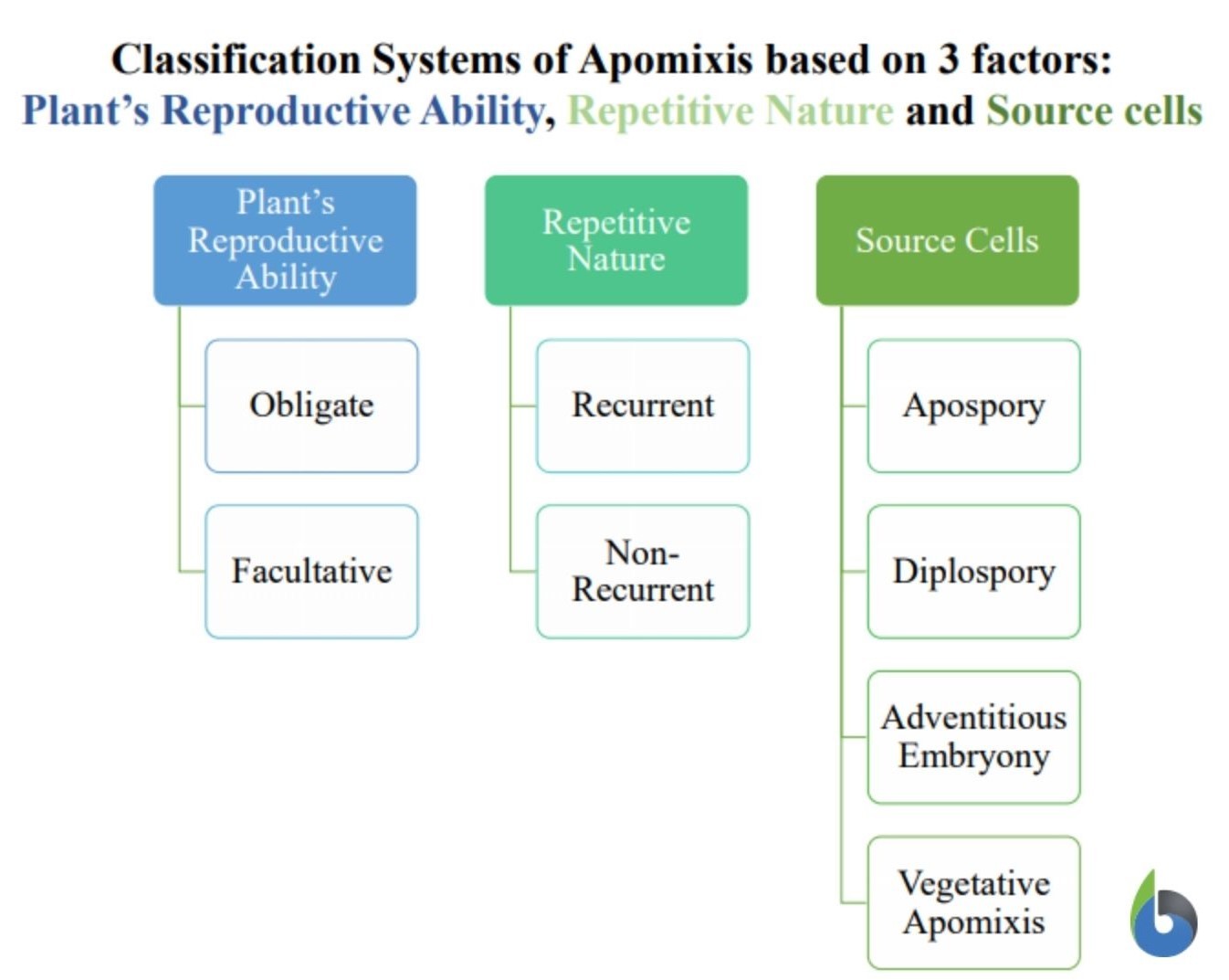
Apomixis in flowering plants is very common, though it has a non-uniform distribution across the angiosperm families. It can be easily noticed in the Rosaceae, Asteraceae, or Poaceae families but is hard to find in Orchidaceae. It has also been noticed that this phenomenon is more common among perennials rather than in ephemerals.
Examples:
- Poaceae: Poa spp, Zea mays
- Asteraceae: Blumea spp., Calendula spp., Tridax spp.
- Rosaceae: Lachemilla spp., Amelanchier spp.
In some flowering plants, apomicts are obligate whereas, in others, they are facultative. Obligate apomicts are those taxa that reproduce solely via this mode of asexual reproduction. Contrastingly, facultative apomicts are those taxa that have both alternatives; reproduce by a sexual mode of reproduction or by apomixis.
Examples:
- Obligate apomixis: Bahiagrass (Paspalum notatum)
- Facultative apomixis: Sea buckthorn (Hippophae rhamnoides), Kentucky bluegrass (Poa pratensis)
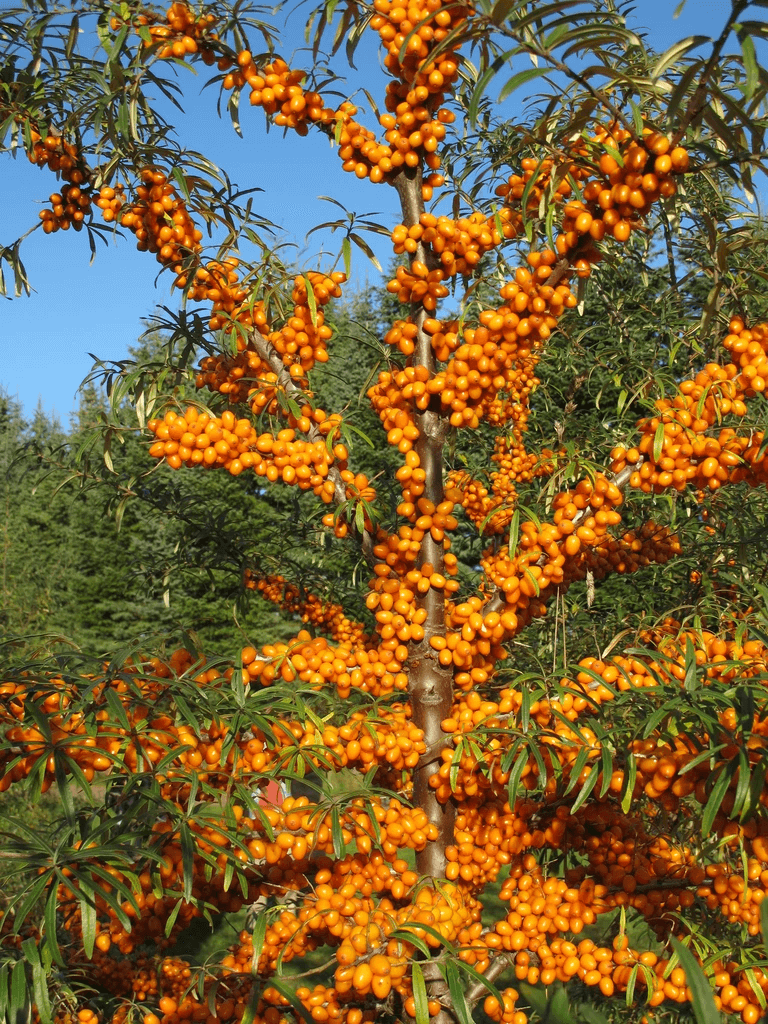
Apomixis types in flowering plants
There are different types of apomixis based on the relative asexual mechanisms analogous with the sexual life cycle of flowering plants. So, when questioned if how do apomicts reproduce, we can draw an analogy between the asexual apomicts and sexually reproducing plants and explain associatively. Broadly classifying, we can say there are 2 major types- vegetative apomixis and agamospermy.
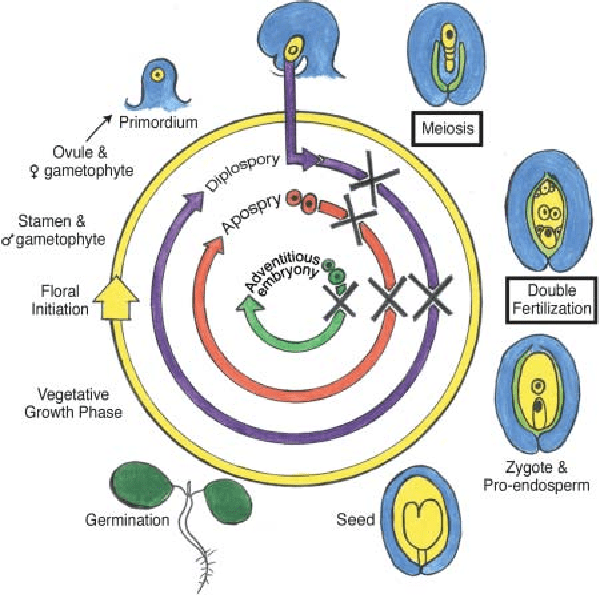
A) Agamospermy
Firstly talking about agamospermy, there are three major types that have been widely researched:
1. Diplospory (type- gametophytic)
A type of gametophytic apomixis in which the embryo sac development is directly from the MMC (megaspore mother cell or archesporial cell) via mitosis and/or interrupted meiosis. Diplospory is further of 2 types- mitotic and modified-meiotic.
2. Apospory (type- gametophytic)
A type of gametophytic apomixis in which the embryo sac development is from the nucellar cells, i.e. gametophyte develops directly from the sporophytic cells without the intervention of meiosis.
3. Adventitious embryony (type- sporophytic)
A type of sporophytic apomixis in which the embryo (new sporophyte) is derived directly from a somatic cell of the ovule (most commonly “nucellar adventitious embryony”). There is the formation of only endosperm inside the embryo sac in such cases. This is entirely a sporophytic form of agamospermy, which often leads to polyembryony like in citrus. Adventitious embryony is commonly observed in Garcinia spp., Mangifera indica, etc.
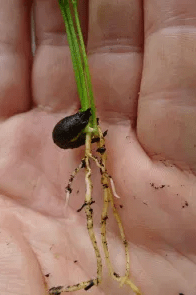
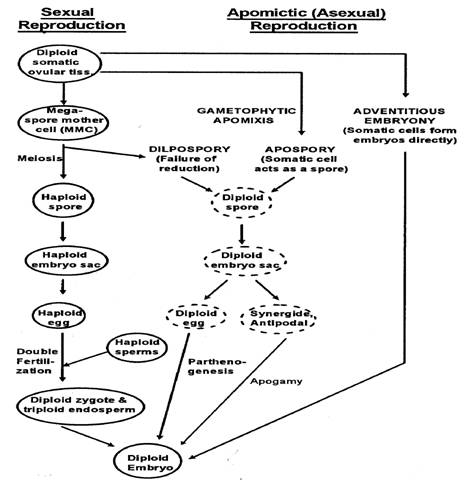
B) Vegetative apomixis
We can’t call types of vegetative reproduction apomixis but we can surely include those that are replacements of sexual reproduction, for example, reproduction by vegetative buds or proliferations at flowering (inflorescence) sites or reproduction via bulblets. It is commonly observed in Allium spp., Agave spp., etc.
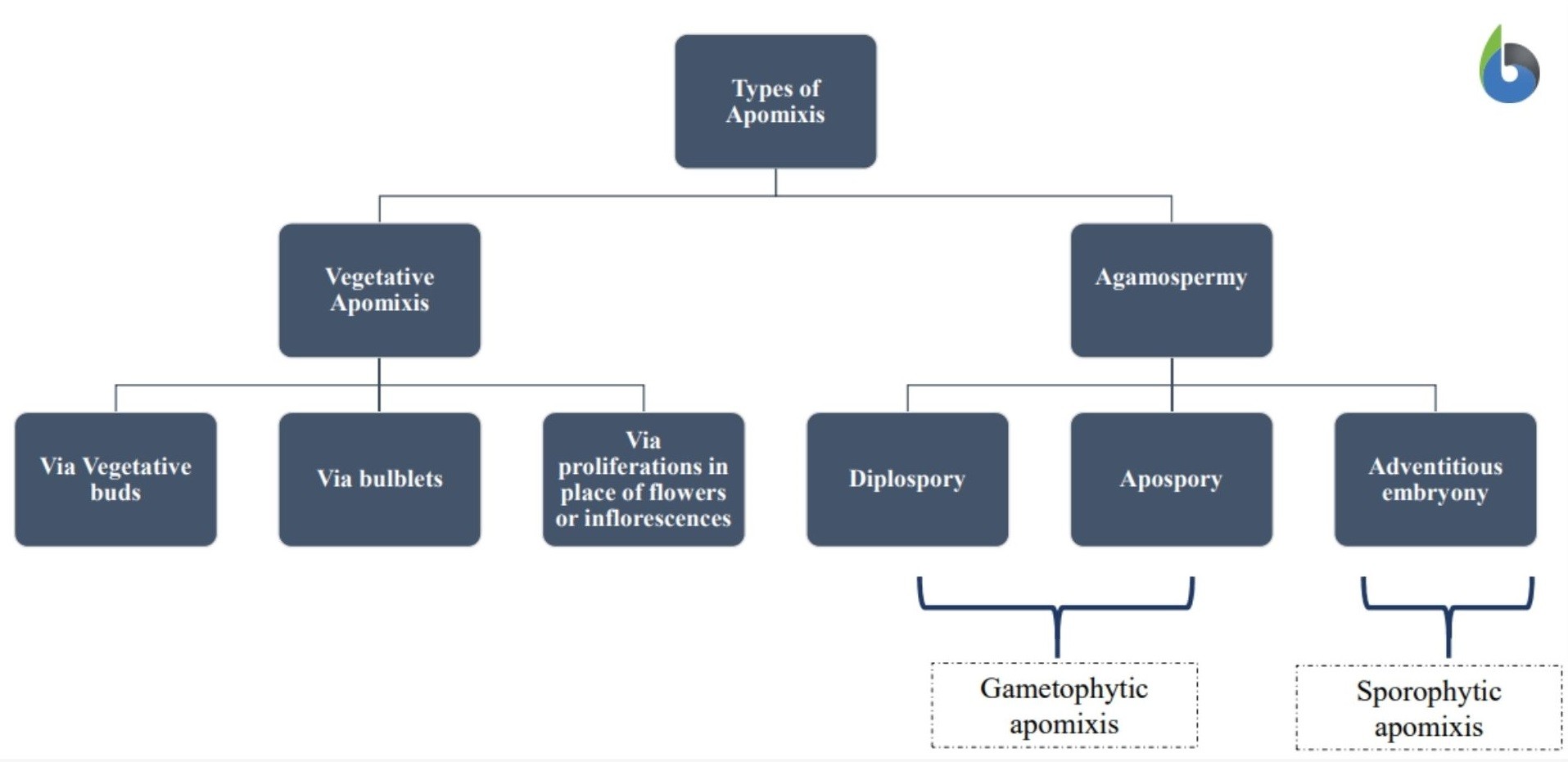
Types of gametophytic apomixis
There are 2 types of gametophytic apomixis namely diplospory and apospory. Both are the same in gametophytic as the step of meiosis is bypassed and an unreduced embryo sac develops from either a cell in MMC or from other ovular cells.
The only difference is that the source of gametophytic apomixis in diplospory is a generative cell while that in apospory is a somatic cell.
Incidence in flowering plants
As the research of apomicts is progressing year after year, we are witnessing their wide distribution and presence in angiosperms. The graph below depicts the increasing discoveries of apomixis in flowering plant taxa where previously it had not been reported (1997–2012).
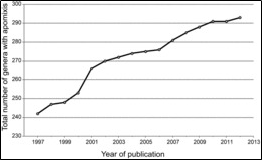
Interesting Fact
Apomixis is inducible in plants using gene-editing mechanisms like CRISPR/Cas9 transgenes. We need to find apomictic loci within the genetic material of the plants and we can hence induce apomixis. How would this be done? CRIPSR/Cas9 is a unique state-of-the-art technology for which E. Charpentier and J. Doudna recently won the Nobel Prize 2020 in Chemistry. (Nobelprize.org, 2020) It is used for editing parts of the genome. If we find the apomictic locus/loci in the genome, we can play around with it and do wonders in plant science. Editing the genome at apomictic loci to maintain hybrid vigor (heterosis) and ease the process of hybrid seed development can bring another revolution in the agriculture and food industry…. (Scheben, 2020)
Hope this info on apomixis helps! Want to hear more? Join our Forum: Asexual and sexual reproduction differences. Connect with an expert.
Try to answer the quiz below to check what you have learned so far about apomixis.
References
- Bicknella, R.A., Koltunow, A.M. (2004) Understanding Apomixis: Recent Advances and Remaining Conundrums. The Plant Cell, 16: 228–245
- Stebbins, G.L. (1941) Apomixis in the Angiosperms. The Botanical Review, 7: 507–542
- Hojsgaard, D., Klatt, S., Baier, R., Carman, J.G., Hörandl, E. (2014) Taxonomy and Biogeography of Apomixis in Angiosperms and Associated Biodiversity Characteristics. Critical Reviews in Plant Sciences. 33(5): 414–427
- Nogler, G.A. (1984) Gametophytic Apomixis. Embryology of Angiosperms. 10: 475-476
- Darrigues A., Daub, J., McCord, K., Rasmussen, C., Rouse, J. (2002) Genetic Analysis of Apomixis. Iowa State University. 1: 1-13
- Martínez, G.L., Philippe, J., Calzada, V. (2019) Chapter Twenty – Apomixis in flowering plants: Developmental and evolutionary considerations. Current Topics in Developmental Biology. 131: 565-604
- Hörandl, E., Hojsgaard, D. (2012) The Evolution of Apomixis in Angiosperms: a reappraisal. Plant Biosystems 146(3):681-693
- Mangla, Y., Chaudhary, M., Gupta, H., Thakur, R., Goel, S., Raina, S.N., Tandon, R. (2015) Facultative apomixis and development of fruit in a deciduous shrub with medicinal and nutritional uses. Annals of Botany Company
- Scheben, A., Hojsgaard, D. (2020) Can We Use Gene-Editing to Induce Apomixis in Sexual Plants? Genes, 11(781);1-28
- Richards, A.J. (1997). Plant Breeding Systems, 2nd ed. (London: Chapman and
Hall). - Winkler, H. (1908). Uber parthenogenesis und apogamie im pflanzenreiche.
Prog. Rei. Bot. 2, 293–454. - Fagerlind F., (1940) Die Terminologie der Apomixis-Prozesse. – Hereditas XXVI
- Gustafsson A. (1944) The Terminology of the Apomictic phenomena. Hereditas
30(1‐2):145 – 151 https://doi.org/10.1111/j.1601-5223.1944.tb03305.x - Nobelprize.org. Press release: The Nobel Prize in Chemistry (2020)
https://www.nobelprize.org/uploads/2020/10/press-chemistryprize2020.pdf
©BiologyOnline.com. Content provided and moderated by Biology Online Editors.

